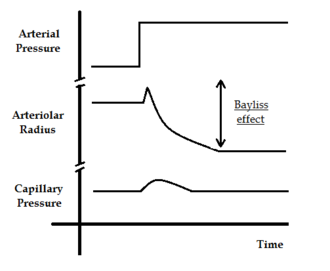Myogenic mechanism
Myogenic Mechanism[edit]

The myogenic mechanism is an intrinsic property of vascular smooth muscle that enables blood vessels to respond to changes in pressure. This mechanism is crucial for the regulation of blood flow and blood pressure within the body, particularly in the kidneys and brain.
Overview[edit]
The myogenic mechanism is a type of autoregulation that occurs in the arterioles, the small branches of arteries. When the pressure within a blood vessel increases, the vessel wall is stretched. This stretch is detected by the smooth muscle cells in the vessel wall, which respond by contracting. This contraction reduces the diameter of the vessel, thereby increasing the resistance to blood flow and maintaining a relatively constant flow despite the increased pressure.
Conversely, when the pressure decreases, the smooth muscle cells relax, allowing the vessel to dilate and decrease resistance, thus maintaining blood flow. This response is known as the Bayliss effect, named after Sir William Bayliss, who first described it in 1902.
Mechanism[edit]
The myogenic response is initiated by the stretch of the vascular smooth muscle cells. This stretch activates mechanosensitive ion channels in the cell membrane, leading to an influx of calcium ions. The increase in intracellular calcium concentration triggers the contraction of the smooth muscle cells.
The contraction of the smooth muscle cells is mediated by the interaction of calcium with the protein calmodulin, which activates myosin light-chain kinase (MLCK). MLCK phosphorylates the myosin light chains, enabling the interaction of myosin with actin filaments, resulting in muscle contraction.
Physiological Importance[edit]
The myogenic mechanism plays a vital role in maintaining stable blood flow to organs that require constant perfusion, such as the brain and kidneys. In the cerebral circulation, it helps protect the brain from damage due to fluctuations in blood pressure. In the renal circulation, it contributes to the regulation of glomerular filtration rate (GFR) by maintaining stable blood flow through the glomerulus.
Clinical Relevance[edit]
Dysfunction of the myogenic mechanism can lead to various pathological conditions. For example, impaired myogenic response in the cerebral circulation can contribute to stroke or cerebral edema. In the kidneys, it can affect the regulation of blood pressure and contribute to hypertension.
Related Pages[edit]
Ad. Transform your life with W8MD's Budget GLP-1 injections from $75


W8MD offers a medical weight loss program to lose weight in Philadelphia. Our physician-supervised medical weight loss provides:
- Weight loss injections in NYC (generic and brand names):
- Zepbound / Mounjaro, Wegovy / Ozempic, Saxenda
- Most insurances accepted or discounted self-pay rates. We will obtain insurance prior authorizations if needed.
- Generic GLP1 weight loss injections from $75 for the starting dose.
- Also offer prescription weight loss medications including Phentermine, Qsymia, Diethylpropion, Contrave etc.
NYC weight loss doctor appointmentsNYC weight loss doctor appointments
Start your NYC weight loss journey today at our NYC medical weight loss and Philadelphia medical weight loss clinics.
- Call 718-946-5500 to lose weight in NYC or for medical weight loss in Philadelphia 215-676-2334.
- Tags:NYC medical weight loss, Philadelphia lose weight Zepbound NYC, Budget GLP1 weight loss injections, Wegovy Philadelphia, Wegovy NYC, Philadelphia medical weight loss, Brookly weight loss and Wegovy NYC
|
WikiMD's Wellness Encyclopedia |
| Let Food Be Thy Medicine Medicine Thy Food - Hippocrates |
Medical Disclaimer: WikiMD is not a substitute for professional medical advice. The information on WikiMD is provided as an information resource only, may be incorrect, outdated or misleading, and is not to be used or relied on for any diagnostic or treatment purposes. Please consult your health care provider before making any healthcare decisions or for guidance about a specific medical condition. WikiMD expressly disclaims responsibility, and shall have no liability, for any damages, loss, injury, or liability whatsoever suffered as a result of your reliance on the information contained in this site. By visiting this site you agree to the foregoing terms and conditions, which may from time to time be changed or supplemented by WikiMD. If you do not agree to the foregoing terms and conditions, you should not enter or use this site. See full disclaimer.
Credits:Most images are courtesy of Wikimedia commons, and templates, categories Wikipedia, licensed under CC BY SA or similar.
Translate this page: - East Asian
中文,
日本,
한국어,
South Asian
हिन्दी,
தமிழ்,
తెలుగు,
Urdu,
ಕನ್ನಡ,
Southeast Asian
Indonesian,
Vietnamese,
Thai,
မြန်မာဘာသာ,
বাংলা
European
español,
Deutsch,
français,
Greek,
português do Brasil,
polski,
română,
русский,
Nederlands,
norsk,
svenska,
suomi,
Italian
Middle Eastern & African
عربى,
Turkish,
Persian,
Hebrew,
Afrikaans,
isiZulu,
Kiswahili,
Other
Bulgarian,
Hungarian,
Czech,
Swedish,
മലയാളം,
मराठी,
ਪੰਜਾਬੀ,
ગુજરાતી,
Portuguese,
Ukrainian